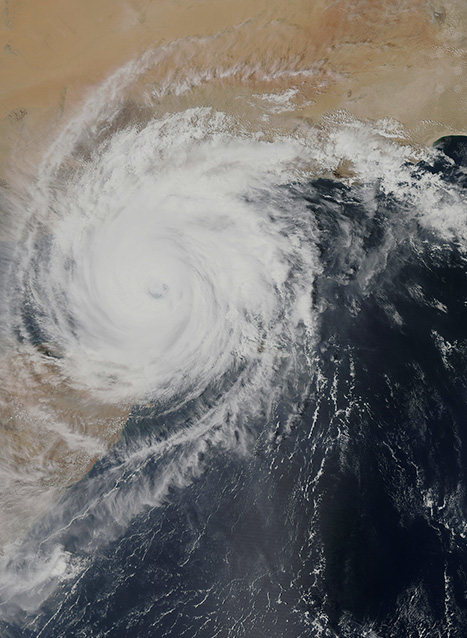Evacuations from Israel and High-Risk Locations Call +44 (0)1202 308810 or Contact Us →

Cyclone Sagar, Gulf of Aden
18 May 2018
Cyclone Sagar is moving across the Gulf of Aden, with anticipated landfall in Somaliland and Djibouti in the early hours of 19 May. Sustained wind speeds within the storm are presently estimated at 95km/h, resulting in hazardous sea conditions, and posing a significant threat to life upon landfall. Based on present conditions, meteorologists asses that the storm is likely to result in up to 150mm of rainfall when it strikes land, exceeding the average annual rainfall for the region.Sea temperatures of 30°C are sufficiently high that the storm is likely to continue to gain energy prior to striking land, with the potential for wind speeds and rainfall to be significantly higher than at present.
Key Points
- Cyclone Sagar is expected to strike the Djibouti-Somali border during the early hours of 19 May 2018.
- Sagar will be the first recorded cyclone to cross the entirety of the Gulf of Aden.
- Severe flooding is highly likely, rainfall over the next 24 hours is anticipated to exceed the region’s yearly average.
Situational Summary
Environmental: Cyclone Sagar is moving across the Gulf of Aden, with anticipated landfall in Somaliland and Djibouti in the early hours of 19 May. Sustained wind speeds within the storm are presently estimated at 95km/h, resulting in hazardous sea conditions, and posing a significant threat to life upon landfall. Based on present conditions, meteorologists asses that the storm is likely to result in up to 150mm of rainfall when it strikes land, exceeding the average annual rainfall for the region.
Sea temperatures of 30°C are sufficiently high that the storm is likely to continue to gain energy prior to striking land, with the potential for wind speeds and rainfall to be significantly higher than at present.
Solace Global Comment
If Cyclone Sagar makes landfall near the Somalia-Djibouti border, it will be the first cyclone to have covered the full extent of the Gulf of Aden since records began in the 1960s. Since then, only two cyclones have made significant progress into the Gulf, with one striking northern Somalia in 1984, and one striking the island of Socotra, before bearing north into Yemen in 2015. It is likely that continued changes to the global climate will see an increasing frequency of severe weather conditions in the region in future.
Aside from the potential for wind damage from Sagar’s initial impact, the most significant effects of the storm are likely to stem from flooding. The Djibouti-Somalia border region consists of extremely arid terrain, and the levels of predicted rainfall are highly likely to result in extensive flash flooding, followed by more persistent river flooding.
Rural inhabitants of the area live in harsh conditions, often relying on subsistence agriculture or pastoral farming, and living within structures ill-suited to severe rainfall. Flooding is likely to result in severe damage to the limited utilities and infrastructure present in the region, with loss of human life highly likely. The impact of the storm’s northern edge as it grazed the Yemeni coast resulted in heavy flooding, fatalities, and is also likely to worsen the rates of cholera infection already plaguing the country. The impact is likely to be much more significant in areas where the storm makes full landfall.
The storm’s impact is also likely to be worsened by poor communication to rural areas, a limited effective early warning system, and by the Islamic festival of Ramadan. Observance of the religious fast is likely to result in lower physical resilience among the population to be hit by the storm, as well as reducing the wider community’s ability to respond to the damage.
In the longer term, it is probable that the effects of the storm will drive further migration out of the area, as the destruction of homes and crops exacerbate the current near-famine conditions in the region and increase vulnerability to disease outbreaks. This may lead to further tensions in urban areas as changes in the demographic status-quo apply pressure to areas in which tribal violence remains frequent.
SECURITY ADVICE
EnvironmentHighTravellers operating in the countries bordering the western Gulf of Aden are advised to closely monitor local media and meteorological information, and to revise their evacuation plans. If in the areas most likely to be struck, withdrawal out of the area, or to a population-centre is strongly recommended, as movement after the storm hits is likely to be severely impeded.
If unable to relocate, travellers should seek shelter in a resilient building, ideally on high-ground, to minimise the impact of flooding. Efforts should be made to accumulate basic survival supplies, including:
For most locations bordering the Gulf of Aden, Solace Global would advise clients to employ the minimum of a security trained driver and the use of an off-road equipped SUV for all travel. It may also be advisable to employ a close protection officer, dependent on location. Solace Global would also advise clients to use travel tracking technology alongside an intelligence feed. This enables a traveller to inform others should an emergency occur and allows them to stay updated on any security-related incident.